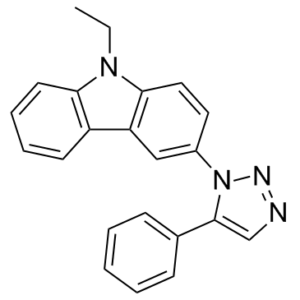MBQ-167
This product is for research use only, not for human use. We do not sell to patients.

For small sizes, please check our retail website as below: www.invivochem.com
| Size | Price | Stock |
|---|---|---|
| 250mg | $925 | Check With Us |
| 500mg | $1480 | Check With Us |
| 1g | $2220 | Check With Us |
Cat #: V3973 CAS #: 2097938-73-1 Purity ≥ 98%
Description: MBQ-167 (MBQ167) is a dual inhibitor of Rac/Cdc42 (Ras-related C3 botulinum toxin substrate and cell division control protein 42 homolog) with anticancer activity.
Top Publications Citing Invivochem Products
Publications Citing InvivoChem Products
Product Promise

- Physicochemical and Storage Information
- Protocol
- Related Biological Data
- Stock Solution Preparation
- Quality Control Documentation
| Molecular Weight (MW) | 338.41 |
|---|---|
| Molecular Formula | C22H18N4 |
| CAS No. | 2097938-73-1 |
| Storage | -20℃ for 3 years in powder formr |
| -80℃ for 2 years in solvent | |
| Solubility In Vitro | DMSO: >155 mg/mLr |
| Water: <1 mg/mLr | |
| Ethanol: >10 mg/mL | |
| Synonyms | MBQ-167; MBQ167; MBQ 167 |
| Protocol | In Vitro | MBQ-167 (≥100 nM) induces a loss of polarity in metastatic breast cancer cells. Treatment with 500 nM MBQ-167 for 24 h results in ~95% cell rounding and detachment from the substratum in metastatic MDA-MB-231 cells. Moreover, MBQ-167 induces this phenotype in multiple mesenchymal cancer cell types including GFP-HER2-BM, MDA-MB-468, and Hs578t human breast cancer cells, as well as Mia-PaCa-2 pancreatic cancer cells, SKOV3 ovarian cancer cells, AGS and NCI-N87 gastric cancer cells, and SH-SY5Y neuroblastoma cells. Following treatment with 250 nM MBQ-167 for 24 h, the attached population of MDA-MB-231 cells demonstrate a ~25% decrease in Rac activation while the detached cells are more responsive with a ~75% decrease. At earlier times (6h), treatment with 250 or 500 nM MBQ-167, induce a inhibition in Rac activity in the attached cell population, while the detached population demonstrate a ~40-50% inhibition |
|---|---|---|
| In Vivo | MBQ-167-treated mice demonstrate a statistically significant reduction in tumor growth. At sacrifice, 1.0 mg/kg BW of MBQ-167 results in a ~80% reduction in tumor growth, and the 10 mg/kg BW MBQ-167 treatment results in ~95% reduction in tumor growth. Since EHop-016 only exerts ~40% reduction of tumor growth at 10 mg/kg BW, MBQ-167 is 10X more effective than EHop-016. MBQ-167 treated mice demonstrate similar doubling times for both treatments (10 and 11 days) |
These protocols are for reference only. InvivoChem does not
independently validate these methods.
| Solvent volume to be added | Mass (the weight of a compound) | |||
|---|---|---|---|---|
| Mother liquor concentration | 1mg | 5mg | 10mg | 20mg |
| 1mM | 2.9550 mL | 14.7750 mL | 29.5500 mL | 59.0999 mL |
| 5mM | 0.5910 mL | 2.9550 mL | 5.9100 mL | 11.8200 mL |
| 10mM | 0.2955 mL | 1.4775 mL | 2.9550 mL | 5.9100 mL |
| 20mM | 0.1477 mL | 0.7387 mL | 1.4775 mL | 2.9550 mL |
The molarity calculator equation
Mass(g) = Concentration(mol/L) × Volume(L) × Molecular Weight(g/mol)
Mass
=
Concentration
×
Volume
×
Molecular Weight*
The dilution calculator equation
Concentration(start)
×
Volume(start)
=
Concentration(final)
×
Volume(final)
This equation is commonly abbreviated as: C1 V1 = C2 V2
Concentration(start)
C1
×
Volume(start)
V1
=
Concentration(final)
C2
×
Volume(final)
V2
Step One: Enter information below
Dosage mg/kg
Average weight of animals g
Dosing volume per animal µL
Number of animals
Step Two: Enter the in vivo formulation
%DMSO
+
%
+
%Tween 80
+
%ddH2O
Calculation Results:
Working concentration:
mg/ml;
Method for preparing DMSO master liquid:
mg
drug pre-dissolved in
µL
DMSO(Master liquid concentration
mg/mL)
,Please contact us first if the concentration exceeds the DMSO solubility of the batch of drug.
Method for preparing in vivo formulation:
Take
µL
DMSO master liquid, next add
µL
PEG300, mix and clarify, next add
µL
Tween 80,mix and clarify, next add
µL
ddH2O,mix and clarify.
Note:
- (1) Please be sure that the solution is clear before the addition of next solvent. Dissolution methods like vortex, ultrasound or warming and heat may be used to aid dissolving.
- (2) Be sure to add the solvent(s) in order.




































